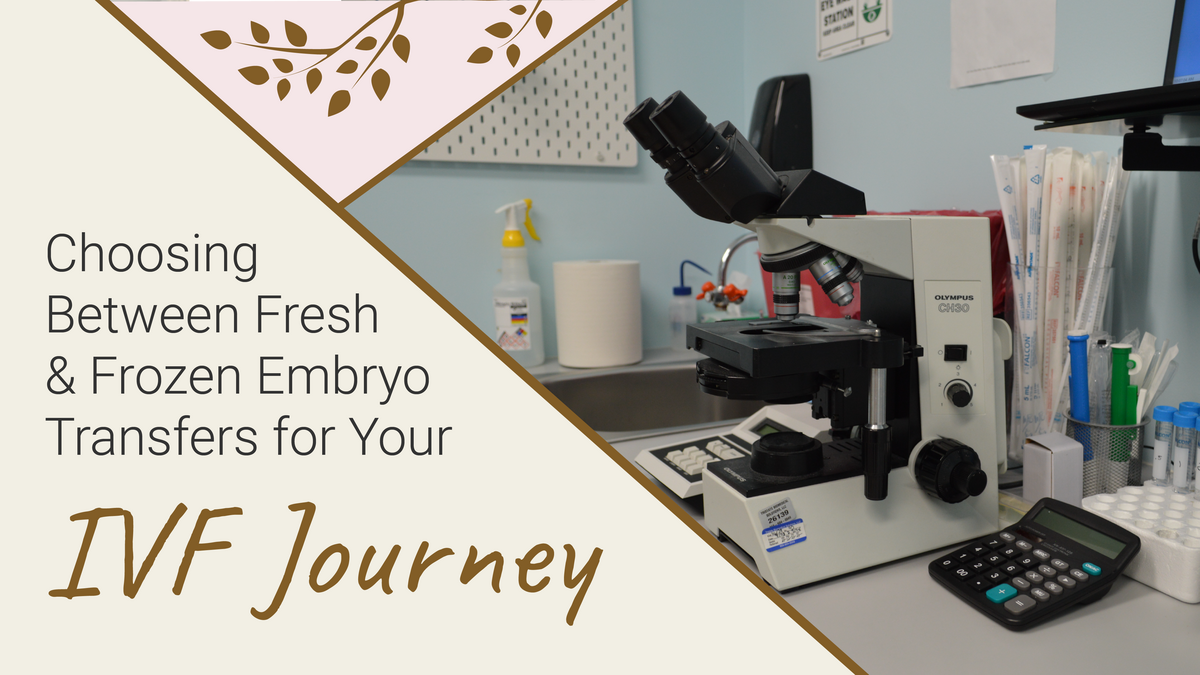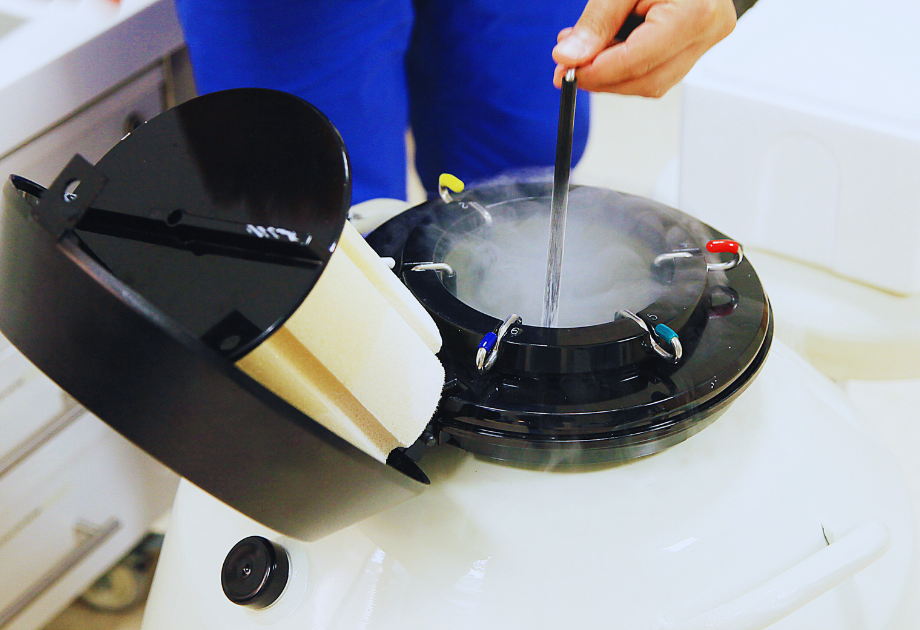Choosing Between Fresh and Frozen Embryo Transfers for Your IVF Journey

If you’re considering or undergoing IVF for your journey to parenthood, the choice between fresh and frozen embryo transfers can feel like a big decision. Both methods have unique benefits and considerations, and understanding the differences can help you make a choice that feels right for your personal journey.
In this guide, we’ll explore each option, breaking down the embryo transfer process and offering insights into what might work best for you and your future family.

Fresh Embryo Transfers: Quick and Natural Timing
A fresh embryo transfer takes place just days after egg retrieval. Here, a mature egg is fertilized, and once the embryo reaches a certain stage, it’s transferred directly into the uterus. Because the embryo is “fresh”—meaning it hasn’t been frozen—the process can feel quicker and more immediate. Shelby, a patient at The Fertility Wellness Institute, describes the anticipation she felt as her fresh embryo transfer took place, explaining, “It felt like everything we’d worked for was happening in real-time.”
The fresh embryo transfer method involves carefully timing each step to align with your natural cycle. However, since the process occurs within the same cycle as egg retrieval, hormone levels are typically higher than with a frozen transfer. This increase in hormones is due to the medications used to stimulate egg production, and it can sometimes lead to side effects or discomfort, as the body has less time to return to its natural balance before implantation, though this only happens very rarely. We’ll talk more about this, soon.
Why Choose a Fresh Embryo Transfer?
Fresh embryo transfers offer the advantage of speed. For patients who are ready to move forward right away, it eliminates the wait time associated with freezing and thawing. Additionally, skipping the freezing process can be more cost-effective, especially if budgeting is a priority. Some couples appreciate the immediacy, feeling that this approach aligns well with their natural timing.
The Challenges of Fresh Embryo Transfers
While fresh transfers can offer a quicker timeline, they do come with certain considerations. Higher hormone levels after egg retrieval can sometimes lead to complications like ovarian hyperstimulation syndrome (OHSS), a condition where the ovaries become swollen and painful. Although OHSS is rare—occurring in only about 1%–5% of IVF cycles—it can cause symptoms such as abdominal pain, bloating, nausea, and, in severe cases, shortness of breath. According to research, women might develop less OHSS after a "freeze-all" strategy compared to the conventional IVF strategy. This suggests that frozen transfers may reduce the risk of OHSS, making them a safer option for some patients.
Additionally, the body's elevated hormone levels during a fresh cycle can sometimes affect the uterine lining, potentially impacting implantation success rates.
Allison, another patient, initially tried a fresh transfer but found that her body needed a break after the retrieval cycle. “It was a learning experience,” she shares. “When we decided to try a frozen transfer later on, I felt calmer and more in control.”

Frozen Embryo Transfers: Flexibility and Control
Unlike fresh transfers, frozen embryo transfers involve cryopreservation, where embryos are frozen and stored until the patient is ready for implantation. This process provides flexibility, allowing time for the body to recover post-retrieval and for additional treatments, such as genetic testing, if desired. With frozen embryos, there’s no rush—the timing can be customized to fit the patient’s needs.
Benefits of Freezing Your Embryos
One of the biggest advantages of frozen transfers is control. Patients can choose the timing, allowing the body to return to its natural hormone levels and reducing the risk of OHSS. Studies have also shown that frozen embryo transfer success rates are comparable to, and sometimes even slightly higher than, fresh transfers. With this approach, patients have the option to test embryos for genetic abnormalities, which can provide added peace of mind.
What to Consider Before a Frozen Embryo Transfer
While frozen transfers provide flexibility, they also require additional steps, including cryopreservation and thawing. This can add time and may slightly increase the embryo transfer cost. However, many find that the benefits of a well-timed transfer and the chance to consider genetic testing make these extra steps worthwhile.
Comparing Success Rates: Fresh vs Frozen Embryos
Studies indicate that frozen embryos may offer a slightly higher cumulative success rate for live births in certain cases, particularly when taking into account the opportunity for multiple transfer attempts. However, both options provide hopeful outcomes, with some studies showing cumulative live birth rates in the range of 57% to 63% for frozen and fresh transfers alike. The choice largely depends on each patient’s preferences, health needs, and timing considerations.
Which Embryo Transfer Is Right for You?
Choosing between fresh vs frozen embryo transfer can be a highly personal decision. Factors like timing, health, and personal comfort all play a role in determining the best fit. If you’re seeking a quicker approach and feel ready after egg retrieval, fresh transfers might be appealing. For those wanting flexibility or considering additional treatments like genetic testing, frozen transfers could be the way to go. Consulting with Dr. Chin can provide further insights based on your unique needs.
The Fertility Wellness Institute: Helping You Choose the Right Path
At The Fertility Wellness Institute of Ohio, we’re here to help you find the best option for your fertility journey. Our compassionate team offers personalized guidance to ensure you feel supported, informed, and empowered. Whether you’re considering a fresh transfer, exploring frozen embryo transfer timeline options, or just starting your IVF journey, we’re with you every step of the way.
The Fertility Wellness Institute: Helping You Choose the Right Path
At The Fertility Wellness Institute of Ohio, we’re here to help you find the best option for your fertility journey. Our compassionate team offers personalized guidance to ensure you feel supported, informed, and empowered. Whether you’re considering a fresh transfer, exploring frozen embryo transfer timeline options, or just starting your IVF journey, we’re with you every step of the way.
Contact The Fertility Wellness Institute of Ohio today to schedule a consultation, and let’s explore how we can help you achieve your dream of parenthood.
Schedule an appointment today!
Follow the Fertility Wellness Institute of Ohio on Facebook, Instagram, X, and LinkedIn!
Do you want to share your fertility journey with the Fertility Wellness Institute of Ohio? Share your story here!

